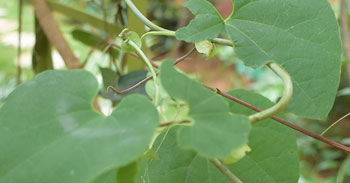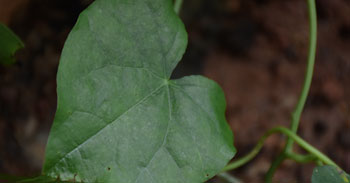KJC Medicinal Garden
Amruthaballi
Tinospora cordifolia
Order: Ranunculales
Family: Menispermaceae
Genus: Tinospora
Species: T. cordifolia
Common Names: Gurjo, Heart-leaved moonseed, Guduchi, Giloy
Native to Tropical regions of the Indian subcontinent
Other plants of the same genus with medicinal properties
-
T. malabarica (Chinese tinspora)
T. crispa (vasanavalli)
- Large deciduous climbing shrub with several elongated twinning branches
- Bark: creamy white to grey brown and warty
- Leaves: Simple, alternate; Green, petiolate up to 15cm long, roundish, pulvinate
- Flowers: unisexual, green-yellow colour, axillary position, male flowers are clustered and females are in solitary and usually grows in summer
- Sepals: 6, two series of 3 each, the inner ones larger than the outer ones
- Petals: 6, smaller than sepals, obovate and membranous
- Fruits: Scarlet or orange red in colour, aggregates of 1-3 ovoid on thick stalk, sub terminal style scars
- Seeds: White, curved, bean shaped
Uses in Tradition systems of medicine
- Used in Ayurveda.
- Claimed to be useful in treating fever, asthma, jaundice, leprosy, diabetes, skin infections and gout.
- Finds mention in the classical texts of Ayurveda, namely, Charak, Sushruta and Ashtang Sangraha
- Vitamin C
- A range of micro and macro elements are present.
- Protein: 0.64g /100g; Fat: 0.14 g/100g; dietry fibres: 0.16g/100g; energy contents: 288.8cal /100g; calcium: 70mg /100g; iron 9.7mg/ 100g.
Suggested Medicinal Properties
- Anti- diabetes property
- Anti-toxic property
- Anti-arthritic property
- Anti-osteoporotic effects
- Anti-HIV effects
- Anti-cancer effects
- Immunomodulatory property
Active Phytochemicals
1. Alkaloids – Stem and root
2. Glycosides- Stem
3. Diterpenoid lactones – Whole plant
4. Steroids – Aerial parts and stem
5. Sesquiterpenoid- Stem
6. Aliphatic compounds – whole plant
7. Miscellaneous compounds – Tinosporic acid, Giolin, Gioloinin, Tinosporidine , Jstrorrhizine, Cordifelone N- trans – feruloyltryamine as diacetate – whole plant and root
References
Pandey, V., Vaishya, J. K., Balakrishnan, P., & Nesari, T. M. (2020). Nutritional aspects of Tinospora cordifolia (Giloe). Medicinal Plants, 12(1), 158–160. https://doi.org/10.5958/0975-6892.2020.00021.0
Saha, S., & Ghosh, S. (2012). Tinospora cordifolia: One plant, many roles. Ancient Science of Life, 31(4), 151. https://doi.org/10.4103/0257-7941.107344
Sharma, P., Dwivedee, B. P., Bisht, D., Dash, A. K., & Kumar, D. (2019). The chemical constituents and diverse pharmacological importance of Tinospora cordifolia. Heliyon, 5(9). https://doi.org/10.1016/J.HELIYON.2019.E02437

